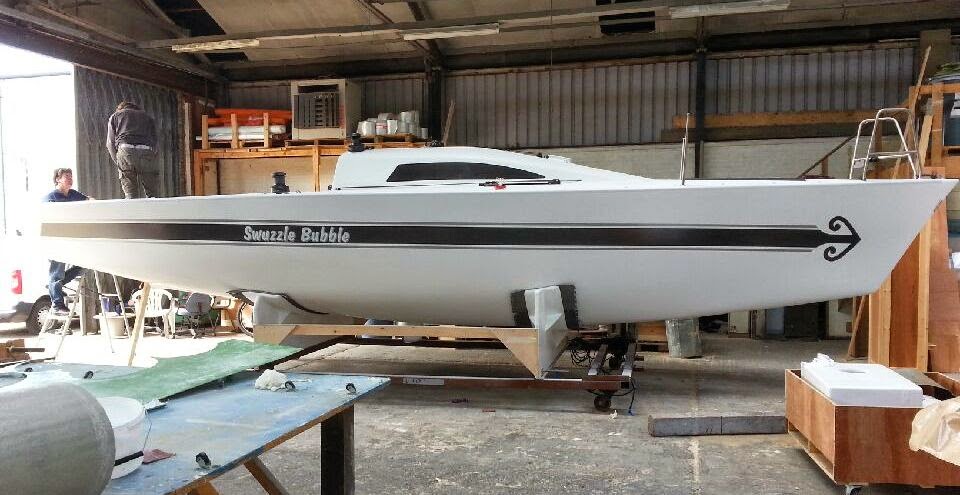Ian Gibbs' original Swuzzlebubble, a Farr designed Half Tonner, was designed and built to contest the 1977 Half Ton Cup, where she represented New Zealand and then went on to form part of New Zealand's winning three-boat team in the 1977 Southern Cross Cup. Later she competed in the 1979 Half Ton Cup, and the history of that period can be seen here.
 |
| Swuzzlebubble during the New Zealand Half Ton Cup trials in 1977 |
 |
| As found in Greece, 2012 |
Swuzzlebubble was found in 2012 by Peter Morton (of Anchor Challenge and Bullit fame) in a very sorry state in Rhodes, Greece. Her hull was largely intact, although the bow was damaged and her keel was in very bad shape and she had been stripped of all gear. Morton has gone about rescuing Swuzzlebubble from
what might have otherwise been her final resting place, and is
currently refurbishing her so that she can join the strong European Half
Ton fleet. As a 'long' Half Tonner and with an impeccable racing
pedigree and experienced new owner she is bound to be a serious
campaigner on the Half Ton circuit.
 |
| Arrival in England - April 2013 |
 |
| Hull fairing and repair of the broken bow section - October 2013 |
 |
| Nearing completion in early April 2014, with new cockpit and deck gear being fitted |
 |
| Swuzzlebubble outside her shed in the Isle of Wight - 7 April 2014 |
 |
| The new hull graphics are added (9 April 2014), retaining her Kiwi heritage with a black and white theme and use of the same koru design on sistership Gunboat Rangiriri |
 |
| The keel is fitted mid-April, the latest in IRC thinking and showing a distinctive concavity in the trailing edge |
 |
| Looking sharp and ready for her new rig |
 |
| First sail - 22 April 2014, and sporting her original 'KZ-3494' sail number! |
These photos documenting the transformation of Swuzzlebubble are courtesy of Peter Morton, and there are more on the Alpha Plus UK site too, and some of the design work can be seen on the BR Yachting Developments blog. For more about the appendage and rig design for Swuzzlebubble, and about the optimisation of former Quarter and Half Tonners, see the comments by Mark Mills here. |
| Swuzzlebubble still going strong, seen here during the 2022 Half Ton Cup (photo Facebook) |
Swuzzlebubble is now sailed in Ireland by current owners David and James Dwyer, and in December 2023 was awarded the Irish Cruiser and Racing Association (ICRA) Yacht of the Year Award. |
| Swuzzlebubble sailing under the burgee of the Royal Cork Yacht Club (photo Afloat magazine) |
Article updated December 2023
 After seeing the transformation of Swuzzlebubble in the previous post, I asked designer Mark Mills for some insights into the conversion of ex-IOR yachts into a race-winning IRC configuration, and he has provided an interesting overview of this process below. Mills was involved in the optimisation of Peter Morton's Farr-designed Half Tonner Swuzzlebubble, and this has followed a number of other successful conversion projects. The keel design used for Swuzzlebubble was also of interest, and so Mills has also explained the theory behind the concave section used in his Quarter and Half Ton projects. Mills' comments might also be helpful for the owners of larger One Tonners who are contemplating conversions to IOR for the 2015 One Ton regatta.
After seeing the transformation of Swuzzlebubble in the previous post, I asked designer Mark Mills for some insights into the conversion of ex-IOR yachts into a race-winning IRC configuration, and he has provided an interesting overview of this process below. Mills was involved in the optimisation of Peter Morton's Farr-designed Half Tonner Swuzzlebubble, and this has followed a number of other successful conversion projects. The keel design used for Swuzzlebubble was also of interest, and so Mills has also explained the theory behind the concave section used in his Quarter and Half Ton projects. Mills' comments might also be helpful for the owners of larger One Tonners who are contemplating conversions to IOR for the 2015 One Ton regatta. 

















